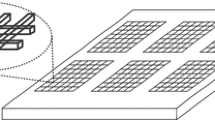Abstract
In view of the significant number of defective nanodevices in the Cmos/nanowire/MOLecular hybrid (CMOL) circuit, defect-tolerant mapping is an essential step to achieve correct logic operations in defective CMOL circuits. However, less effort has been made to improve circuit delay by defect-tolerant strategies. In this paper, the factors affecting the delay of mapped circuits are analyzed, and the path-tree based defect-tolerant mapping method for the delay optimization is proposed. From the logic-domain, the terminology of the path tree is presented, and the logic circuit is first partitioned into multiple path trees. Then, the mapping areas in the physic-domain are pre-planned for (near) critical path trees. During the mapping process, the specific mapping modes and an updating strategy are formulated to map the path trees: inputs are mapped based on input sorting; (near) critical path trees are mapped with priority, while the others are mapped in a hierarchical way. Finally, an improved tabu search algorithm is employed to verify the validity of the proposed defect-tolerant mapping method. Experimental evaluations on the ISCAS benchmarks show that the proposed method can reduce circuit delay by 15.22%.
Similar content being viewed by others
References
Goldstein S C, Budiu M. Nanofabrics: Spatial computing using molecular electronics. SIGARCH Comput. Archit. News, 2001, 29(2): 178-191. https://doi.org/10.1145/384285.379262.
DeHon A. Nanowire-based programmable architectures. J. Emerg. Technol. Comput. Syst., 2005, 1(2): 109-162. https://doi.org/10.1145/1084748.1084750.
Lu W, Lieber C M. Nanoelectronics from the bottom up. Nature Materials, 2007, 6(11):841-850. https://doi.org/10.1038/nmat2028.
Strukov D B, Likharev K K. CMOL FPGA: A reconfigurable architecture for hybrid digital circuits with two-terminal nanodevices. Nanotechnology, 2005, 16(6): 888-900. https://doi.org/10.1088/0957-4484/16/6/045.
Likharev K K. Hybrid CMOS/nanoelectronic circuits: Opportunities and challenges. J. Nanoelectron. Optoelectron., 2008, 3(3): 203-230. https://doi.org/10.1166/jno.2008.301.
Madhavan A, Sherwood T, Strukov D B. High-throughput pattern matching with CMOL FPGA circuits: Case for logic-in-memory computing. IEEE Trans. Very Large Scale Integr. (VLSI) Syst., 2018, 26(12): 2759-2772. https://doi.org/10.1109/TVLSI.2018.2809644.
Sait S M, Oughali F C, Arafeh A M. Engineering a memetic algorithm from discrete cuckoo search and tabu search for cell assignment of hybrid nanoscale CMOL circuits. J. Circuits Syst. Comput., 2016, 25(04): Article No. 1650023. https://doi.org/10.1142/S0218126616500237.
Xia Y, Chu Z, HungWN N, Wang L, Song X. An integrated optimization approach for nanohybrid circuit cell mapping. IEEE Trans. Nanotechnol., 2011, 10(6): 1275-1284. https://doi.org/10.1109/TNANO.2011.2131153.
Tunali O, Altun M. A survey of fault-tolerance algorithms for reconfigurable nano-crossbar arrays. ACM Comput. Surv., 2018, 50(6): Article No. 79. https://doi.org/10.1145/3125641.
Ariga K, Lee M V, Mori T, Yu X, Hill J P. Two-dimensional nanoarchitectonics based on self-assembly. Adv. Colloid Interface Sci., 2010, 154(1/2): 20-29. https://doi.org/10.1016/j.cis.2010.01.005.
Yan H, Choe H S, Nam S, Hu Y, Das S, Klemic J F, Ellenbogen J C, Lieber C M. Programmable nanowire circuits for nanoprocessors. Nature, 2011, 470(7333): 240-244. https://doi.org/10.1038/nature09749.
Yuan B, Li B. A fast extraction algorithm for defect-free subcrossbar in nanoelectronic crossbar. ACM J. Emerg. Technologies Comput. Syst., 2014, 10(3): Article No. 25. https://doi.org/10.1145/2517137.
Sasikumar D, Kumar A. A novel defect tolerance scheme for nanocrossbar architectures with enhanced efficiency. Micromachines, 2018, 10(1): Article No. 14. https://doi.org/10.3390/mi10010014.
Yuan B, Li B, Chen H H. Defect- and variation-tolerant logic mapping in nanocrossbar using bipartite matching and memetic algorithm. IEEE Trans. Very Large Scale Integr. (VLSI) Syst., 2016, 24(9): 2813-2826. https://doi.org/10.1109/TVLSI.2016.2530898.
Hung W N N, Gao C, Song X, Hammerstrom D. Defect-tolerant CMOL cell assignment via satisfiability. IEEE Sens. J., 2008, 8(6): 823-830. https://doi.org/10.1109/JSEN.2008.923261.
Sait S M, Arafeh A M. Reconfiguration-based defect-tolerant design automation for hybrid CMOS/nanofabrics circuits using evolutionary and non-deterministic heuristics. Arab. J. Sci. Eng., 2015, 40(9): 2515-2529. https://doi.org/10.1007/s13369-015-1682-1.
Chen D, Xia Y, Wang Z. Stuck-at-close defect propagation and its blocking technique in CMOL cell mapping. Microelectron. J., 2018, 72: 100-108. https://doi.org/10.1016/j.mejo.2017.12.004.
Morgul M C, Tunali O, Altun M, Frontini L, Ciriani V, Vatajelu E I, Anghel L, Moritz C A, Stan M R, Alexandrescu D. Integrated synthesis methodology for crossbar arrays. In Proc. the 14th IEEE/ACM Int. Symp. Nanoscale Architectures, Jul. 2018, pp.91-97. https://doi.org/10.1145/3232195.3232211.
Xu Q, Chen S, Geng H, Yuan B, Yu B, Wu F, Huang Z. Fault tolerance in memristive crossbar-based neuromorphic computing systems. Integr. VLSI J., 2020, 70: 70-79. https://doi.org/10.1016/j.vlsi.2019.09.008.
Kule M, Rahaman H, Bhattacharya B B. Maximal defect-free component in nanoscale crossbar circuits amidst stuck-open and stuck-closed faults. J. Circuits Syst. Comput., 2019, 28(11): Article No. 1950180. https://doi.org/10.1142/S0218126619501809.
Chu Z, Xia Y, Hung W N N, Song X, Wang L. Timing-driven logic restructuring for nano-hybrid circuits. Int. J. Electron., 2013, 100(5): 669-685. https://doi.org/10.1080/00207217.2012.720945.
Zha X, Xia Y. Defect-tolerant mapping of CMOL circuits with delay optimization. In Proc. the 30th ACM Great Lakes Symp. VLSI, Sept. 2020, pp.451-456. https://doi.org/10.1145/3386263.3406944.
Cong J, Xiao B. Defect tolerance in nanodevice-based programmable interconnects: Utilization beyond avoidance. In Proc. the 50th ACM/EDAC/IEEE Des. Autom. Conf., May 29-June 7, 2013, Article No. 9. https://doi.org/10.1145/2463209.2488745.
Sait S M, Arafeh A M. Cell assignment in hybrid CMOS/nanodevices architecture using tabu search. Appl. Intell., 2014, 40(1): 1-12. https://doi.org/10.1007/s10489-013-0441-9.
Matrosova A, Ostanin S, Chernyshov S. Finding false paths for sequential circuits using operations on ROB-DDs. In Proc. the 24th IEEE Int. Symp. On-Line Testing and Robust System Design, July 2018, pp.240-242. https://doi.org/10.1109/IOLTS.2018.8474213.
Brglez F, Bryan D, Kozminski K. Combinational profiles of sequential benchmark circuits. In Proc. IEEE Int. Symp. Circuits and Systems, May 1989, pp.1929-1934. https://doi.org/10.1109/ISCAS.1989.100747.
Author information
Authors and Affiliations
Corresponding authors
Supplementary Information
ESM 1
(PDF 128 kb)
Rights and permissions
About this article
Cite this article
Zha, XJ., Xia, YS., Xie, SL. et al. Defect-Tolerant Mapping of CMOL Circuit Targeting Delay Optimization. J. Comput. Sci. Technol. 36, 1118–1132 (2021). https://doi.org/10.1007/s11390-021-0904-0
Received:
Accepted:
Published:
Issue Date:
DOI: https://doi.org/10.1007/s11390-021-0904-0



